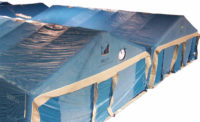AIA Task Force Launches Tool to Collect Designs of Alternative COVID-19 Care Sites

The Javits Center is one of four temporary care facilities erected in New York City in the past two weeks.
Photo © New York National Guard via Flickr
The AIA's new coronavirus pandemic task force—launched March 26 to help inform public officials, healthcare facility managers, and architects on adapting existing buildings into temporary medical sites—is now asking architects, designers, and engineers to share their knowledge about the design of alternative healthcare facilities. The COVID-19 ArchMap, which came online Friday, April 3, allows users to contribute to the AIA's growing database of information.
Read the full statement published by the organization:
“An American Institute of Architects (AIA) task force is asking architects, designers, engineers and facility owners around the globe to provide design information on COVID-19 alternative healthcare sites for a new online resource launching today.
AIA’s task force has created the online tool to facilitate information sharing and the development of best practices for responding to COVID-19 and future pandemics. As part of the new online resource, architects, designers, engineers and facility managers worldwide can input information on alternative care sites into AIA's survey. Information will appear on the COVID-19 ArchMap, which was produced in partnership with the Kansas University Institute of Health + Wellness Design. The task force developed this tool to catalog current public health and healthcare facility response and to serve as a research database moving forward.
Additionally, the task force is currently creating a preparedness assessment tool to assist individuals—who are not experienced healthcare designers—with evaluating buildings for alternative healthcare operations in a non-healthcare setting during the COVID-19 response. The tool will include a variety of considerations in a checklist format for whether a site is appropriate to be an alternative care site.
AIA’s task force—announced last week—is comprised of architects with a wide range of expertise, including healthcare facility design, urban design, public health and disaster assistance.
AIA is encouraging federal, state and local governments to adapt appropriate existing—and especially vacant or temporarily unused—buildings to meet the growing healthcare and quarantine needs resulting from the COVID-19 pandemic.
Visit AIA’s website for more COVID-19 resources for members.”



